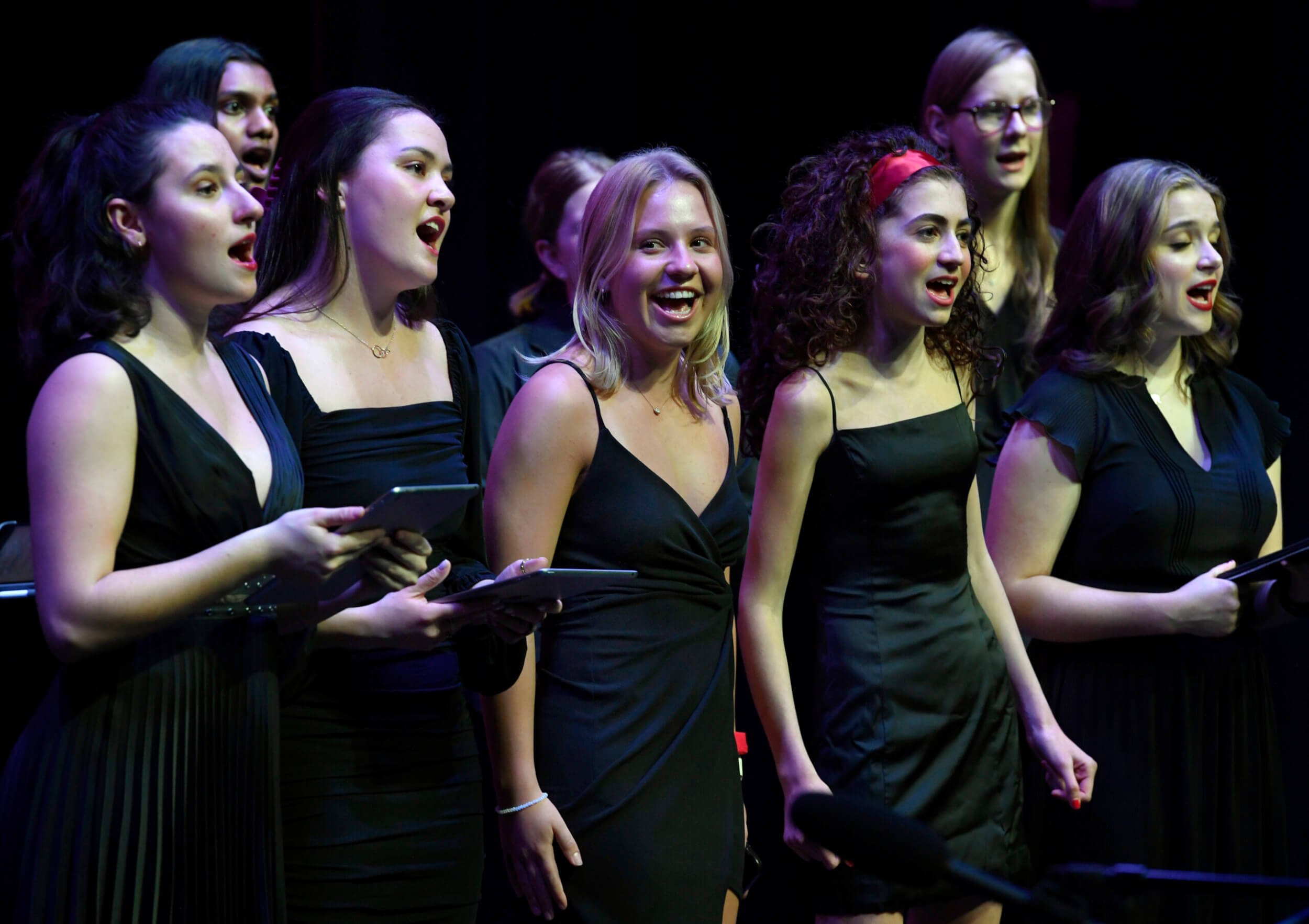It is fortunate that Phil Jones, Colorado Academy’s Music Department Chair, plays more than one instrument—a lot more. Proficient on the saxophone, flute, clarinet, trumpet, trombone, guitar, bass, piano, and drums, Jones needs a huge range of skills to instruct Lower, Middle, and Upper School musicians in a plethora of classes, individual instrument lessons, and ensembles throughout the year.
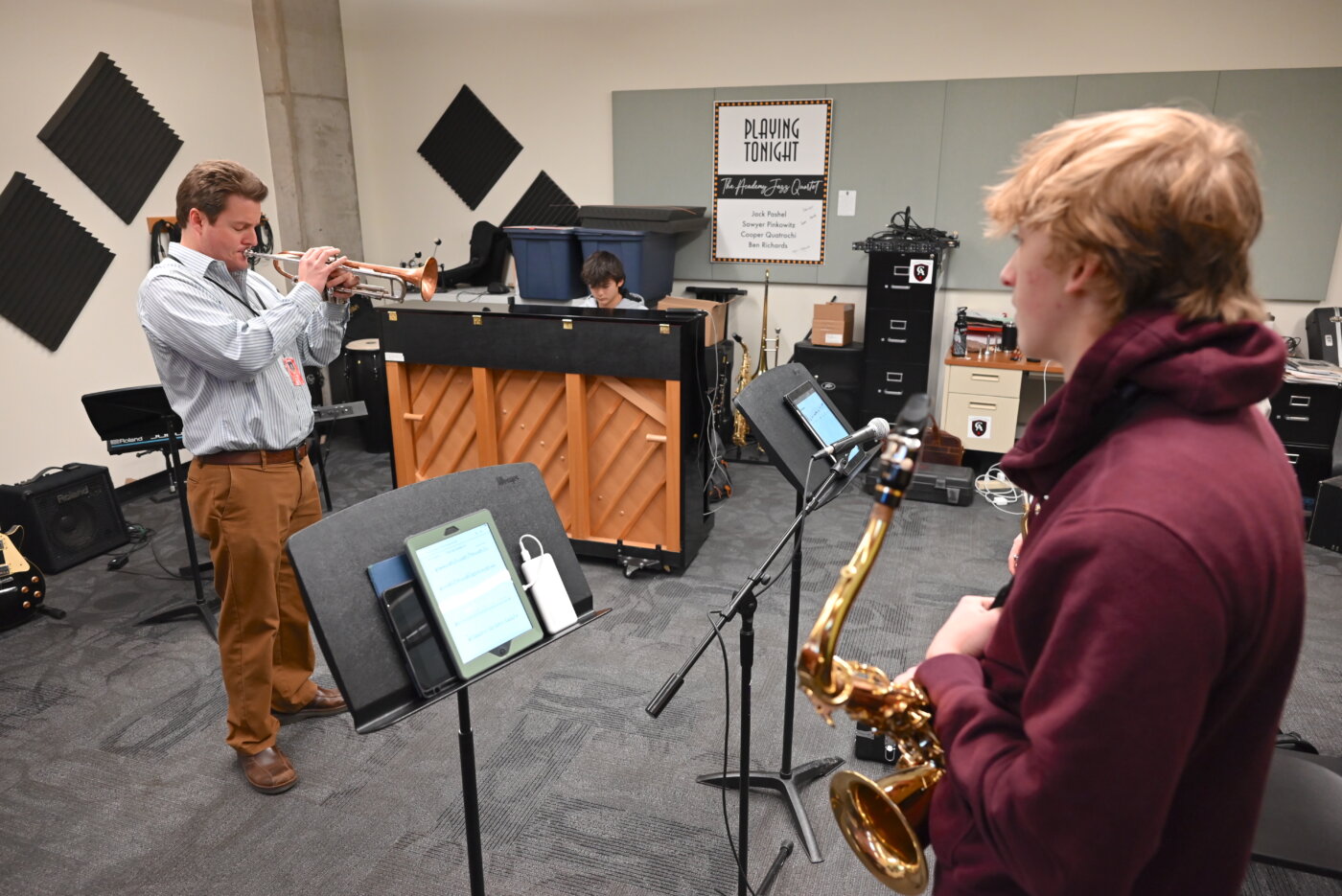
“Pretty much every half hour of the day, it’s a new experience,” he says. “I’ll go right from teaching a Lower Schooler in a private instrument lesson to conducting an Upper School group.” This year, although Jones usually works with students in Fourth Grade and up in individual lessons, he’s taken on additional students as young as First Grade to satisfy increasing interest in private instruction, which already occupies CA’s seven instrumental music instructors full time.
The demand for Jones’s expertise—and that of his Music Department colleagues—speaks to the scope and popularity of the CA music program, particularly at the Middle and Upper School levels, where he spends the bulk of his time. From Sixth to Twelfth Grade, students can find a way to pursue seemingly any musical path at CA, from mastering an instrument to exploring music theory. This is because the program, according to Jones, is adept at meeting students where they are.
“We love when we get to ask students, ‘What is your goal with music? How far do you want to go with it?’ Whatever it is, we’ll help you do that.” Jones and his colleagues Dr. Kevin Padworski, Vocal Music Director, and Jennifer Arnold, Orchestra and Chamber Music Coordinator, purposely keep classes and ensembles small to maximize the time they are able to spend with individual students. And if regular offerings aren’t enough, then they’ll invent a new class or create another avenue for a musician to pursue their passion. That was the origin of Padworski’s Upper School Music Theory class, a year-long, AP-level course of study that introduces students to the foundations of Western music and prepares them for advanced work in college.

But the program isn’t just for those students for whom music is everything. “Whether they continue with it after CA or not,” Jones explains, “I just want them to have the experience—the discipline, the frustration, and the joy—that comes with music. There are other things in life that can give you some of the skills you gain from music, but I don’t think there’s anything else where you learn that resilience, that sensitivity, and that ability to collaborate with others in quite the same way.”
Middle School
In the Lower School, CA students participate in general music classes, and they can choose to join the Lower School Choir or take private instrument lessons in piano, violin, viola, cello, flute, clarinet, saxophone, trumpet, trombone, guitar, and music composition. When they reach the Middle School, musicians encounter a whole new world of possibilities.
According to Padworski, the Middle School music program is more robust than ever, offering students opportunities not only to build their skills, but also to find their place in CA’s music community. “I want my Sixth to Eighth Grade students to have had the experience of singing and playing music with others—that exposure to ensemble work is so crucial at this age,” he says.

Padworski—a skilled multi-instrumentalist (as a music education major, he was required to learn every instrument) who is an active composer and award-winning artistic director and conductor outside of CA—is particularly proud of the choral groups he leads in the Middle School. These include the Seventh and Eighth Grade Choir and the new club choir, which he introduced as an option during study hall block for students who can’t otherwise fit music into their busy schedules.
“The club choir was immediately successful—25 students signed up when I launched it. Having an outlet like this is so important during Middle School, particularly for those who identify as male and are going through a voice change. I can work with them to keep singing through that transition.”
Groups like these serve as a “social landing ground” for students, as well, Padworski explains. “Kids who may be outliers in other areas thrive in these spaces because they’re able to be themselves and just create music together.”
Padworski also teaches a Sixth Grade music course, part of the grade’s yearlong arts rotation, which covers music history, critical listening, and performance fundamentals, as well as the Seventh Grade Music Tech elective, which introduces students to digital music technology, composition, and film scoring.
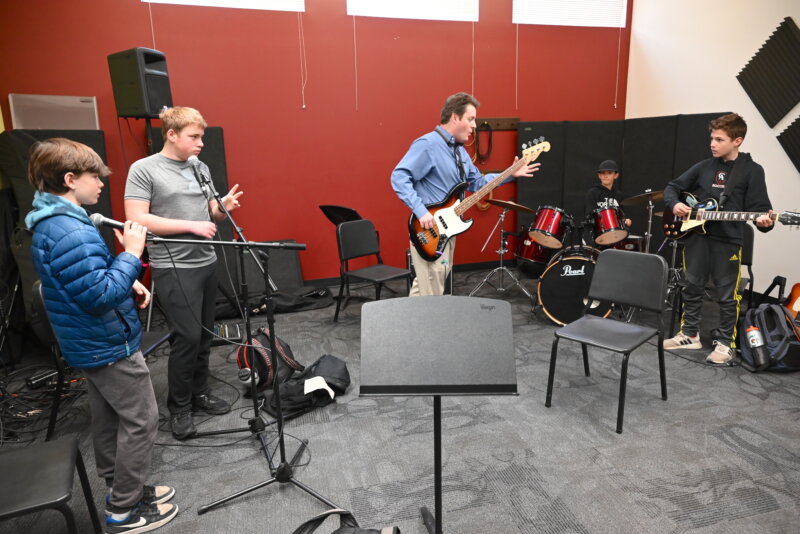
Jones, for his part, rounds out the Middle School offerings with the Seventh and Eighth Grade Instrumental Lab, a course that introduces students to instruments such as guitar, bass, drums, and keyboard, along with the Seventh and Eighth Grade Jazz Ensemble and Rock Band, performance groups that emphasize creativity, discipline, and the essentials of music theory.
String, woodwind, and piano players have their own home in one of two Middle School orchestras—Grade Six and Grades Seven and Eight—or one of more than a dozen chamber ensembles organized by Arnold. Offering such a wide variety of performance opportunities is rare for a school of CA’s size, Arnold says. “With such a huge percentage of our students participating in the private lesson program, the orchestras and ensembles give our musicians experience playing with others, reading music, learning to count, and creating harmony.”
These groups, and especially the recitals that showcase their hard work throughout the school year, are a highlight of the Middle School program, says Jones. “When students who may be in the private lesson program or studying outside of school have the opportunity to come together with their friends and make music, it’s incredible.”
Upper School
CA’s music program for Upper Schoolers is even more expansive than its Middle School counterpart. A rich slate of electives allows students in Grades Nine through Twelve to expand their creative range in new fields and to audition to participate in CA’s marquee performing groups and productions. Upper School performers are the “headliners” at frequent concerts and other big school events, where the community enjoys celebrating its most accomplished musicians.
As Arnold says, “We always tell these kids, ‘We have a lot to keep you busy.’”
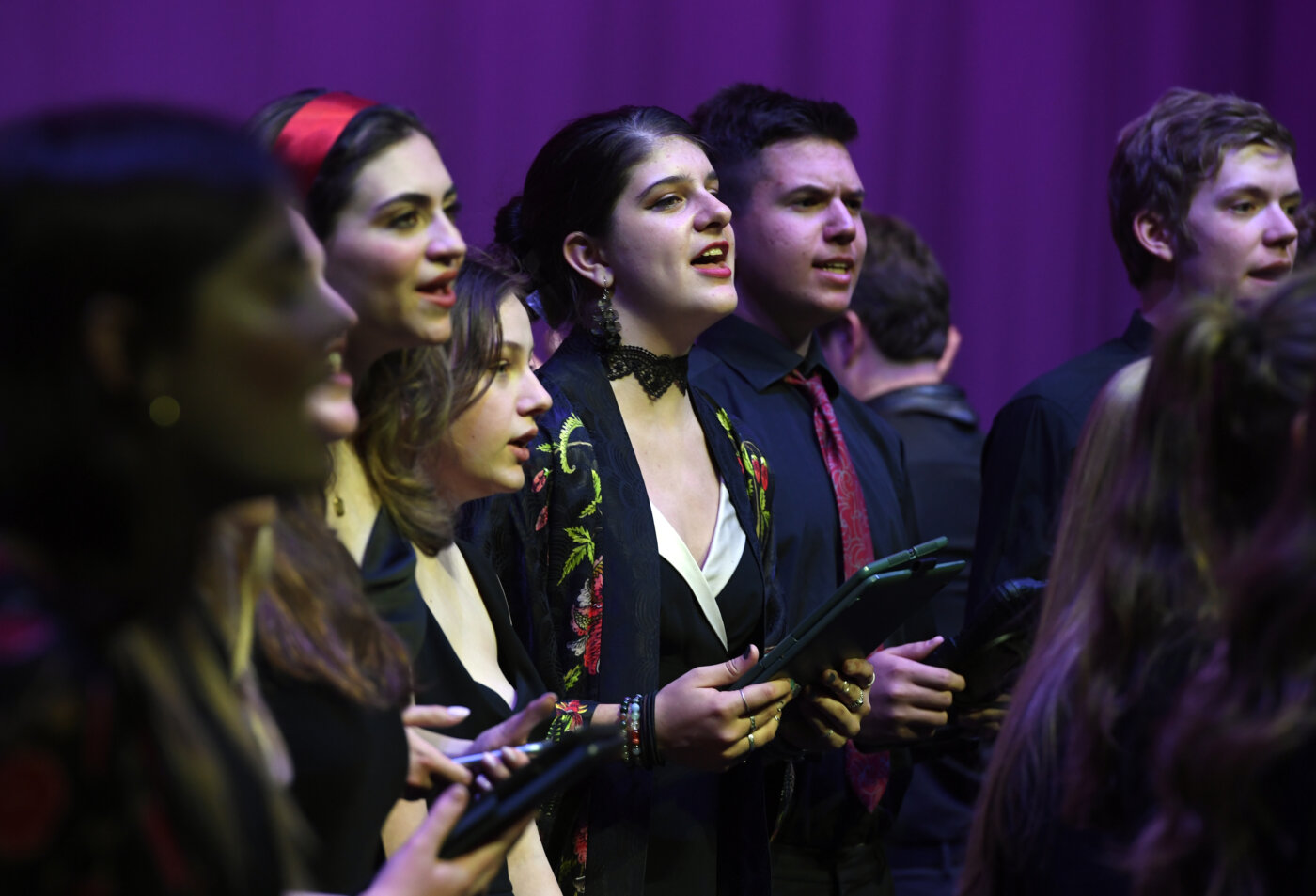
Fed by an influx of singers and instrumentalists graduating from CA’s Middle School program, as well as those arriving from other schools and private instructors, the Upper School experience supports and challenges students as they gain a real sense of who they are as performers and how they can contribute to the music culture at CA, explains Padworski.
“We give students the opportunity to explore and to reach the next level of their musicianship, which for us is really working on deeper, more complex pieces of music for multiple-part ensembles,” he says.
The options include Concert Choir, Orchestra, and chamber ensembles, as well as the audition-based Chanteurs, Academy Jazz, and Rock Band. Each of these, according to Padworski, is its own platform for increasingly meaningful musical experiences. “One day, my students may no longer remember a particular melody, but they will remember making music and who they made it with. I can think back to every single one of those experiences in my own career. And for me, our job is creating more of those opportunities for our musicians.”
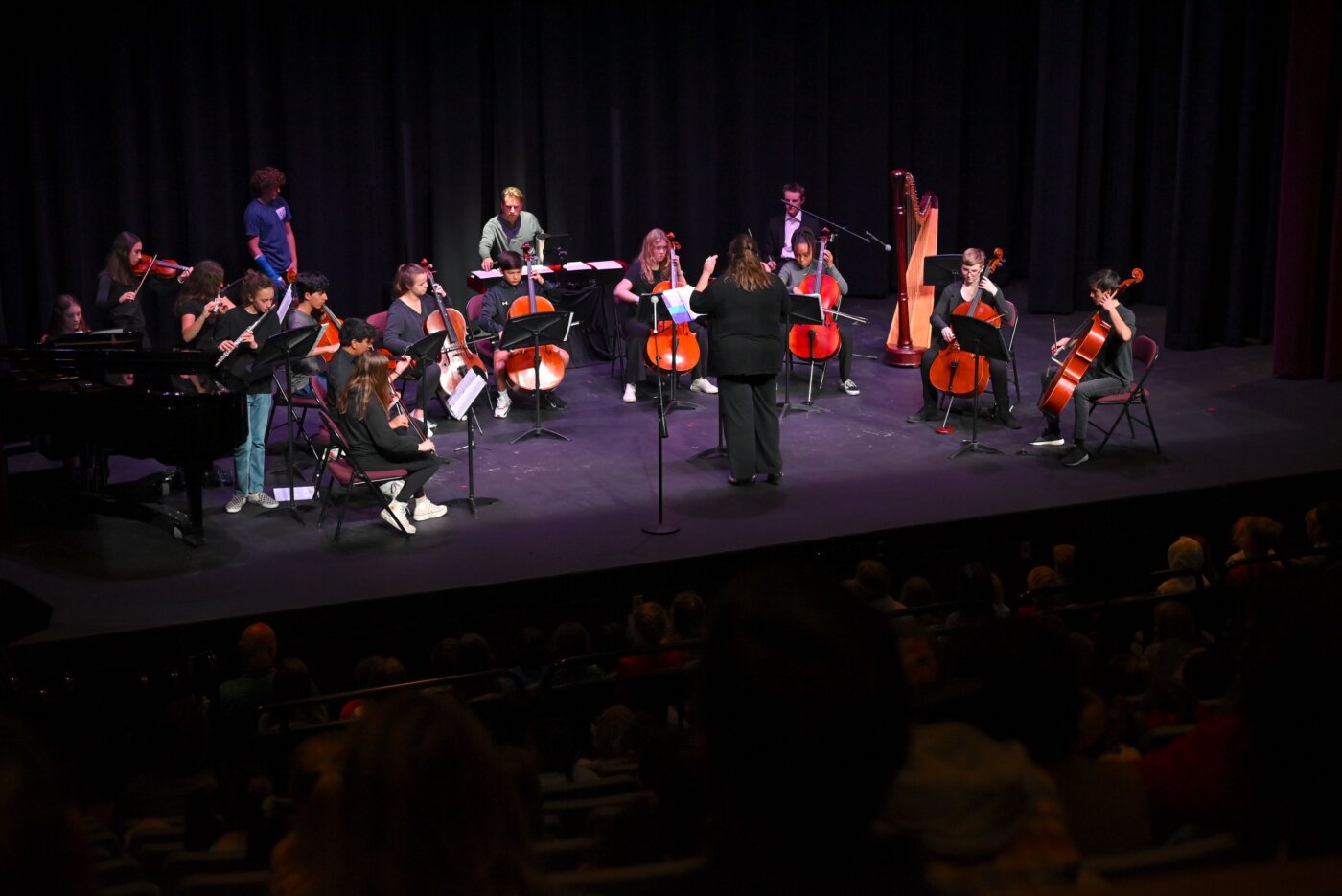
Arnold adds, “When my students reach that point where they can play the music they want to play, and do it with their friends, they just light up. CA is special in the way that’s a part of the culture that everyone celebrates.”
In Academy Jazz and Rock Band, Jones emphasizes students’ sense of ownership in crafting performances. “I don’t tell them what songs we’re going to play,” he says. “I have the students make a list of what they might like to try, and we narrow it down from there.”
Meanwhile, in Concert Choir and Chanteurs, Padworski relishes working with singers who may need coaching to see their own potential. “We obviously love shining a spotlight on those musicians who come to us with natural talent and confidence, but I feel equally as excited to work with those kids who are suddenly able to find their voice and command the stage, when they never before thought they could do that. Those are life-changing moments—they gain their identity as a musician and can build toward more success.”
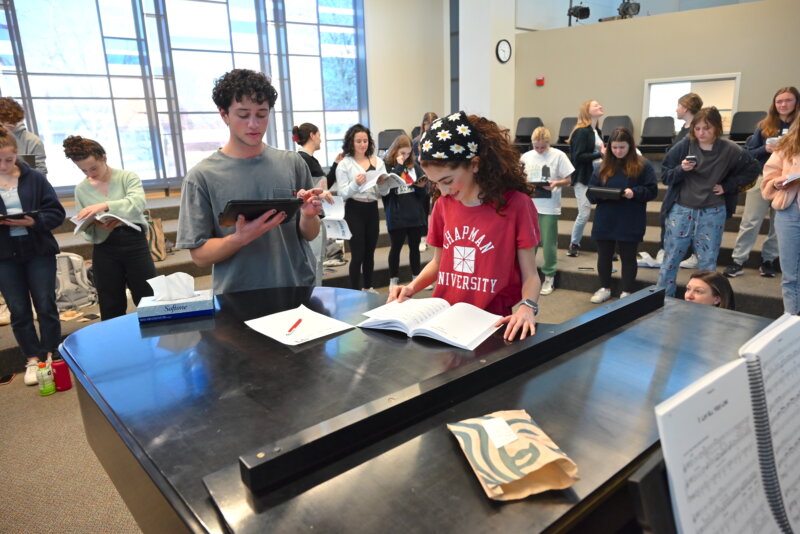
Additional Upper School courses, including Audio Engineering and Music Theory, take students deeper. The unique Musical Theater class, co-taught by Padworski and Middle and Upper School theater instructor Maclain Looper, offers a workshop-style environment in which aspiring performers delve into the techniques that will be essential when they participate in the Upper School spring musical, a highlight of the CA arts calendar.
The musical, says Padworski, underscores an important overlap between the two departments. Of the fact that cast members are frequently the very same students who populate the various musical groups on campus, he says, “That’s our challenge, but also our joy—being able to see these kids thrive in all the ways that matter to them.”
Looking ahead
As leaders, Jones, Padworski, and Arnold are constantly looking to push the Middle and Upper School music programs in engaging new directions. In February, the Upper School Rock Band and Chanteurs joined forces at the annual Upper School Concert to create a big, unique sound. “We wanted to break down silos,” explains Padworski. “Giving students the opportunity to see into each other’s worlds is invaluable. It’s a way for them to gain new understanding, respect, and appreciation.”
Adds Jones, “Experiencing what a large, dynamic ensemble sounds like can really open students’ eyes up to the possibilities of music.”

Delivering audience-pleasing versions of Simon & Garfunkel’s gospel-tinged “Bridge Over Troubled Water” and A-ha’s dance hit “Take On Me,” the combined groups’ performance reminded Jones of one of his proudest moments in 10 years at CA: conducting Middle Schoolers as they sang Pink Floyd’s “Another Brick in the Wall,” the most famous line of which goes, “We don’t need no education!”
With the Rock Band-Chanteurs collaboration, he says, “We were looking for a way to give our students an experience similar to that one—something they maybe hadn’t done at school before.”
Padworski, who has worked with professional musicians and performing groups around the country, is using his extensive network of connections to pursue new opportunities away from the CA campus.
“Of course, we have an amazing space in the Leach Center for the Performing Arts that we want to celebrate and open up to the community,” he says. “But at the same time, it’s important for us to share the gifts and the good fortune that we have, and to deliver that out into the community as a form of service.”
Two such excursions are already in the works: one to a memory care facility, where CA students will sing for residents, and another at a food bank, where they’ll both volunteer and offer a performance.
Padworski is working on plans for another trip, this one to the Canada Choral Festival in June, when he’ll invite CA students to join professional singers on stage in Toronto and Montreal. And in summer 2024 he’ll do the same when he takes the stage of New York’s Carnegie Hall to conduct the New England Symphonic Ensemble performing his own Reflections on a Mexican Garden.
Jones is busy working to secure the same sorts of opportunities for the musicians in Academy Jazz and Rock Band. After a successful trip last spring to the huge UNC-Greeley Jazz Festival, Jones hopes to book more such gigs in the near future. “Getting out of our ‘CA bubble’ and playing for people besides their parents is really important for these students,” he says. “There’s really nothing else that compares to the pressure and the excitement of a big performance.”
But for one event early this May, CA’s many musicians will all be on campus, starring in a musical kickoff to the annual All-School Arts Festival. The evening gala will feature the Upper School jazz and rock ensembles, Orchestra, and Concert Choir, along with improvisation classes courtesy of the Theater Department, a food truck, and even lawn games.
It will be yet another opportunity for Jones to witness a few more of the moments that he describes as among the most fulfilling for him as a teacher.
“When you have that student who just has worked so hard, and you see it all come to fruition, and they have that great performance—you think, ‘Yes! That’s what we’ve been working for.’ It’s their moment, but it’s also about the collaboration, the work we put in together to get to this point.”
